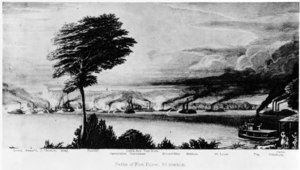Confederate service
Renamed General Sumter, the ram proceeded to Fort Pillow, Tennessee, on 17 April 1862 to be armed.
On 10 May 1862, defending the main avenue to Memphis, Tennessee, Montgomery′s fleet of eight vessels attacked a force of Union ironclads. In the resulting Battle of Plum Point Bend, 4 miles (6.4 km) above Fort Pillow, General Sumter, with Raphael Semmes in command, steamed within 20 yards (18.3 meters) of the Union Navy Mortar Boat No. 16, whose projectiles were threatening the fort, and fired everything she had, including a rifle volley; two 32-pound (14.5-kg) shot pierced the iron blinds of the Union mortar boat. [3]
Then the sidewheel steamer CSS General Sterling Price and General Sumter cooperated in a well-executed coordinated attack, one after the other, ramming the casemate gunboat USS Cincinnati at full speed so that she lost her rudder and much of her stern; Cincinnati (which Montgomery reported as the ironclad gunboat Carondelet) had to be run ashore to avoid sinking. Next, General Sumter rammed and damaged the gunboat USS Mound City, but was damaged by gunfire herself. [2] Thus, the Confederate rams held off the Union flotilla until the fort was successfully evacuated on 1 June 1862. They then retired to Memphis to refuel.
Quickly following up the capture of Fort Pillow, U.S. Navy Flag Officer Charles H. Davis appeared off Memphis in force on 6 June 1862. Montgomery, cornered without enough coal to retreat to Vicksburg, Mississippi, yet unwilling to scuttle his fleet, fought it out desperately in the First Battle of Memphis. General Sumter rammed and seriously damaged the sidewheel paddle steamer USS Queen of the West, but eventually most of the Confederate vessels were destroyed or surrendered. [4] General Sumter did not sink; badly shot up, she ran on the shore of the Arkansas River, was captured, refloated, and renamed Sumter by the Union Navy.
This page is based on this
Wikipedia article Text is available under the
CC BY-SA 4.0 license; additional terms may apply.
Images, videos and audio are available under their respective licenses.
